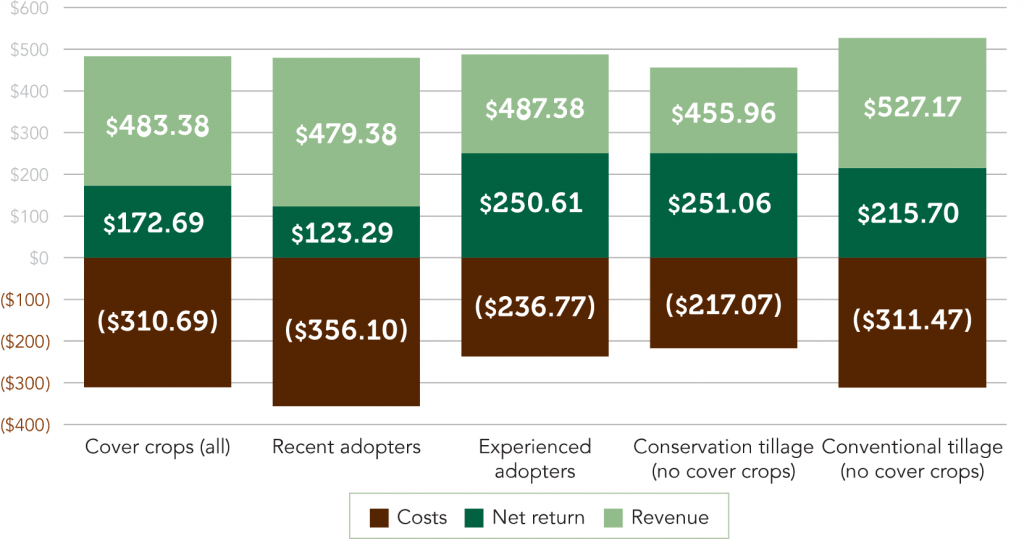This blog was originally posted on Soil Health Partnership’s blog.
When it comes to cover crops, patience combined with realistic expectations is often the name of the game. Unlike the immediate cost savings that often come with conservation tillage, cover crops have annual costs as well as efficiencies and soil health benefits that can take time to achieve.
These are some of the reasons why in our report, Conservation’s Impact on the Farm Bottom Line, we found experienced cover crop users were more profitable when compared to new adopters.
As you can see in the graphs below, experienced cover crop adopters (more than five years of experience with the practice) had some of the lowest costs and highest profitability per acre of anyone in our study — including both recent cover crop adopters (less than five years of experience with the practice) and those using conventional tillage with no cover crops. So how did they do it?
Per-acre costs by tillage and cover crop groups, corn
Per-acre costs by tillage and cover crop groups, soybeans
Identifying ways to reduce seed costs
There is one line item that inevitably arises when farmers adopt cover crops: new expenses for cover crop seed. While this may come as no surprise, finding ways to reduce these costs is one of the ways experienced cover crop users save money as compared to those just starting out. Over the years, experienced adopters are often able to identify savings by:
- Using different suppliers or sources.
- Growing their own cover crop seed.
- Experimenting with different seed mixes.
- Adjusting seeding rates.
Finding the right seeding method
Experienced cover crop users were also able to identify cost savings by adjusting their seeding method to identify the best approach for their operation.
Some found time and labor savings by contracting out broadcast or aerial application of their cover crop seed. Others found that drilling the seed with existing equipment was the most cost-effective given their geographic, soil and labor needs. And, in many cases, farmers found the best way to reduce cover crop costs on their farms was to combine cover crop seeding with other field operations, such as broadcasting seed with a fall fertilizer application or incorporating with a fall tillage pass.
Using program support where available
For some experienced cover crop users, another way to save costs was to use conservation program funding where possible. Since cover crop adoption does come with a learning curve and up-front costs, these programs help farmers make the transition with less financial risk. Some of the programs used included:
- USDA NRCS Environmental Quality Incentives Program.
- USDA NRCS Conservation Stewardship Program.
- North Racoon Farm to River Partnership (Iowa-specific).
- Iowa Department of Agriculture and Land Stewardship Cover Crop Crop Insurance Project (Iowa-specific).
While these programs usually don’t fully cover the costs of implementing a cover crop, they help farmers in the implementation phase as they are finding what works best on their farm and as they start to experience the soil health benefits of this practice.
There’s no doubt about it — the financial dynamics of adopting cover crops are less straightforward than for conservation tillage. However, when approached as a long-term investment that can provide sustained benefits from soil health and soil function over time, the farmers featured in our report provide evidence that the profitability dynamics of cover crops over time begin to look more favorable.











